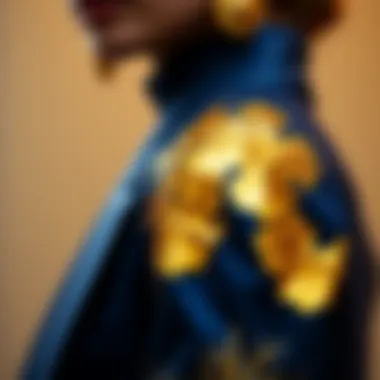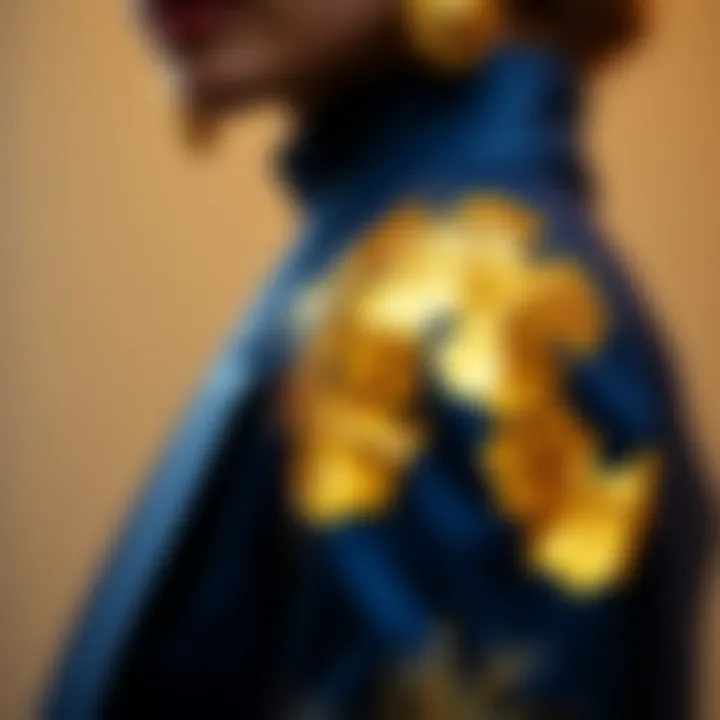Exploring Gold Foil Flake: History and Modern Impact


Intro
Gold has long been a symbol of wealth and opulence, captivating hearts and minds throughout history. Lately, this allure finds itself manifesting in a contemporary iteration through a rather surprising medium: gold foil flake. Delving into the rich background of this shimmering material, we find a story that marries ancient techniques with modern aesthetics. As we navigate the journey of gold foil flake in the fashion realm, we discover a powerful narrative about craftsmanship, innovation, and the complex nuances of sustainability in today’s marketplace.
Within the world of haute couture and street style alike, gold foil flake transforms garments and accessories, elevating them into the realm of luxury while stirring debates around ethical sourcing and eco-friendly practices. It’s a tale of beauty and responsibility, of artistic flair contrasted with the urgent need for sustainability.
From its origins to its present-day applications, this exploration will unravel how designers are harnessing gold foil flake to capture the imagination of fashion enthusiasts and set industry benchmarks. Through a careful examination of current trends and attitudes, we will connect the dots between aesthetic value and moral implications, providing insights fit for both the discerning sartorialist and the retail professional.
"Fashion is a form of self-expression, but the materials we choose define much more than just aesthetics."
Get ready to delve into the many facets of gold foil flake, a beautiful element that serves as a touchstone for both luxury and ethical discussions in modern fashion.
Latest Fashion Trends
Seasonal Style Highlights
Gold foil flake has permeated various seasonal trends, seamlessly adapting to the whims of fashion enthusiasts. Recent collections have showcased its versatility—from chic metallic accent pieces such as handbags adorned with delicate gold detailing to high-end evening gowns that sparkle under the lights.
- Spring/Summer Collection: Many designers are opting for pastel palettes highlighted by gold accents. Think airy fabrics peppered with gold foil flakes for an ethereal effect.
- Autumn/Winter: Metallic tones become a staple, with gold foil flakes integrated into heavier fabrics like velvet and wool, adding depth and luxury.
Influential Runway Looks
Runways around the globe have become a stage for gold foil flake to shine. Designers are pushing the envelope, incorporating this material into striking designs that resonate with audiences.
Some notable examples include:
- Gucci: A collection featuring gold foil embellished jackets and dresses created a buzz, emphasizing extravagance without overlooking wearability.
- Balenciaga: Their use of exaggerated silhouettes paired with gold foil accentuations challenged traditional fashion norms and captivated critics worldwide.
This integration of gold foil flake is not just a passing trend; it's shaping the visual identity of contemporary fashion, inviting admiration and reflection into the vibrancy it offers.
Sustainable Fashion Practices
Ethical Sourcing of Materials
As the dialogue around sustainability intensifies, industry players are prioritizing ethical sourcing of materials, including the gold used for foil flakes. Many brands have begun to investigate the origins of their gold, opting for recycled sources or ensuring that suppliers follow socially responsible mining practices. This shift aims to minimize the environmental and social impact of mining activities, particularly in regions where exploitation is rampant.
Fashion labels are increasingly transparent about their supply chains, aiming to build trust with consumers who are more concerned than ever about the origin of their products. By adopting such approaches, they contribute to a shift toward responsible consumption in fashion.
Eco-Friendly Clothing Care
Caring for garments adorned with gold foil features is another aspect of sustainable practices. Consumers have been encouraged to adopt eco-friendly cleaning and maintenance methods to prolong the life of these fashion items, reducing waste and promoting sustainability.
- Hand Washing: Instead of machine washing, which can damage delicate embellishments, opting for hand washing with gentle detergents is advisable.
- Air Drying: Avoiding high heat, let the pieces air dry to preserve the integrity of gold foil.
For further exploration of the historical significance of gold in fashion, consider checking out Britannica or delve into modern perspectives on sustainability in the industry at reditt.com.
By reviewing the multifaceted nature of gold foil flake, we aim to offer insight into not just trends, but the greater implications of choice and consequence in fashion today.
Keep an eye on this illuminating journey as we continue to pull back the curtain on the stories hidden within the glittering facade of fashion.
Prelude to Gold Foil Flake
Gold foil flake, a distinct and luxurious material, has carved a niche for itself in both the art and fashion worlds. Often perceived as a symbol of opulence, its incorporation into contemporary fashion designs speaks volumes about the evolving nature of personal expression through attire. By exploring the origins, methods of application, and wide-ranging implications of gold foil flake, we can truly appreciate its place in today’s design landscape.
Defining Gold Foil Flake
Gold foil flake is meticulously crafted from real gold, transformed into extremely thin sheets or flakes. This process involves hammering or rolling the gold down to a fraction of its original thickness, resulting in delicate pieces that shimmer and shine. Unlike standard gold used in jewelry, gold foil flake is airy and light, making it ideal for decorative purposes in fashion. Its composition can vary, but it typically consists of 22 to 24-karat gold, ensuring that the final product retains its value and allure.
The beauty of gold foil flake lies not just in its inherent value, but in the way it can elevate a design. Whether sprinkled atop a garment or embedded within a textile, the piece takes on a new life, showcasing a fusion of luxury and creativity. When applied correctly, gold foil flake can transform a mundane fabric into a work of art, highlighting the ingenuity of the designer.
Historical Significance
Tracing the lineage of gold foil flake brings us back to ancient civilizations where gold was revered not merely for its beauty but for its representation of wealth and status. Egyptians famously used gold leaf to adorn sarcophagi and temples, symbolizing the divine and the eternal. Similarly, during the Byzantine era, gold leaf was employed extensively in religious art and decoration, reflecting the power of the church and the aristocracy.
"Gold foil has transcended time and culture, continually symbolizing luxury and artistry."
As history marched forward, the techniques grew more refined, yet the essence remained unchanged. Fast forward to today, and designers from various walks of life are utilizing this age-old technique to make a statement in modern fashion. The historical weight carried by gold foil flake enhances its appeal, inviting fashion enthusiasts and artisans alike to connect with the past while creating something new.
Production Processes
The production processes behind gold foil flake are what turn a naturally occurring metal into an artistic element that captivates and inspires designers. Understanding these processes not only reveals the skill and craftsmanship involved but also highlights the broader implications for the fashion industry. Techniques of production and application are foundational to appreciating how gold foil flake plays a role in modern fashion.
From Raw Gold to Flake


Producing gold foil flake begins with raw gold, which is mined, refined, and ultimately transformed into thin sheets. The journey from ore to flake involves several critical steps:
- Mining: Gold is extracted from the earth, often deep in the ground. Methods vary from artisanal mining to large-scale operations. Each method comes with its own environmental impact and economic considerations.
- Refining: After extraction, the gold must be purified, typically through chemical processes like cyanidation or electrolysis, to remove impurities. This stage is vital for achieving the high quality desired for fashion applications.
- Milling: Once refined, gold is rolled into sheets. This rolling process is delicate; if not done correctly, the gold can tear or become uneven.
- Cutting: Finally, the gold sheets are cut into flakes. The thickness can vary, which influences how the flakes are used in design and application.
This meticulous process ensures that the end product meets the standards required for luxury items, marrying artistry with precise craftsmanship.
Techniques of Application
Once gold flakes are produced, applying them to textiles and other mediums sets the stage for their function in fashion. Various techniques are adopted across the industry, each with its pros and cons.
Usage in Textile Techniques
When discussing the application of gold foil in textiles, several techniques stand out. Artists and designers often employ methods like:
- Foil Printing: This technique utilizes heat to adhere the gold flakes onto fabric, enhancing texture and visual appeal. It's a popular choice for creating statement pieces that catch the eye.
- Embroidery: Incorporating gold flakes into embroidery gives depth and a luxurious feel to designs. The key characteristic of this method is its versatility, blending well with various fabrics.
- Screen Printing: In this technique, gold flakes can be printed alongside inks to create stunning patterns. This method allows for intricate designs that would be hard to replicate by hand.
The benefit of using gold flakes in textiles often lies in their ability to elevate an otherwise mundane fabric into something extraordinary. However, potential downsides, including cost and difficulty in care, can influence the decision of artisans and brands.
Adhesives and Coatings
The role of adhesives and coatings in applying gold foil flakes cannot be overlooked. They are crucial in ensuring that the gold stays in place. Popular choices for adhesives include:
- Water-based Glue: This is a common and eco-friendly option that allows for easy application. It dries clear, making it visually appealing.
- Spray Adhesives: These provide a quick application but may not always hold up under stress, which can be a significant factor in garments subject to movement.
The unique feature of these adhesives lies in their ability to bond strongly without compromising the delicate nature of the gold foil. Each has advantages and disadvantages; for instance, while some adhesives allow for flexibility in fabric movement, others may prove too rigid, causing the gold flakes to crack or peel off.
Adhering gold foil flakes requires a balance of artistic vision and practical application, making the choice of both techniques and adhesives pivotal.
The production processes and applications discussed in this section lay the groundwork for understanding how gold foil flake has become a staple in fashion today. Through careful production and innovative applications, gold flakes bring out the opulence and artistry that defines contemporary fashion.
Applications in Fashion
The world of fashion is not just about fabric and fit; it’s also about embellishment, storytelling, and self-expression. The use of gold foil flake elevates garments, marrying traditional craftsmanship with contemporary flair. Its significance is far-reaching. One can argue that it serves as a symbol of affluence and artistry, capturing attention and admiration in equal measure. Moreover, it's versatile, finding a place in both high-end and artisanal settings, which makes it worthy of exploration.
High Fashion and Luxury Brands
Bridal Attire
Bridal attire is often the epitome of elegance and luxury, and gold foil flake plays a crucial role in achieving that ethereal look. It transforms traditional gowns into breathtaking works of art. The sparkle of gold against soft fabric can turn a simple silhouette into something truly breathtaking. This aesthetic appeal makes it a popular choice for designers aiming to create memorable pieces.
One striking characteristic of bridal attire featuring gold flakes is its ability to capture light beautifully. This shimmers not only enhances the visual experience but also creates a certain warmth that complements the emotional ambiance of weddings. However, while it is a beneficial choice for most, some might find that the delicate nature of gold foil—and its potential to detach from the fabric—could pose logistical issues. Despite this potential drawback, the luxurious association with gold maintains its allure in the bridal market.
Runway Shows and Couture
Runway shows are not merely a platform for showcasing clothes; they are an event that encapsulates the zeitgeist of fashion. Gold foil flake has found its way onto these towering stages, accentuating design innovation. Its reflective nature can serve as a dramatic statement, capturing the audience’s gaze from the moment the lights come on. Designers make use of this element to push boundaries, exploring avant-garde concepts that often challenge conventional beauty norms.
One key characteristic of runway garments embellished with gold flakes is their narrative quality. They communicate not just through fabric and design but also through their luminescence. This compelling visual dialogue invites the audience to partake in a creative experience. On the flip side, such audacious designs can be polarizing. Some might argue they overshadow the craftsmanship behind the clothing itself. Nonetheless, gold foil retains its status as an essential highlight on the runway, underscoring innovation while provoking thought.
Artisan Crafts and Custom Pieces
Artisan crafts and custom pieces showcase how gold foil flake transcends mere embellishment to become a medium for personal expression. Artisans around the globe have integrated gold flakes into their work, crafting unique items that resonate with individual stories and cultural heritage. This type of craftsmanship emphasizes an individual's skills, making each piece not just an item of clothing but a story woven into fabric.
The bespoke nature of custom designs utilizing gold foil creates intimate connections between artisans and clients. Each flake tells a tale; from the process of sourcing materials to the final fitting, it makes receiving a custom piece a memorable experience. However, the discrepancies in production times and costs can sometimes deter potential buyers. Still, the allure of owning something one-of-a-kind that captures personal style remains compelling, making it a worthwhile investment for many fashion enthusiasts.
"Gold foil flake is not merely about appearance; it's about capturing stories and elevating art to an emotional level."
In summary, the applications of gold foil flake in fashion are as diverse as they are impactful. From luxurious bridal wear to bold runway pieces and artisanal crafts, this decorative element ultimately represents a fusion of creativity, culture, and personal expression.
Cultural Implications
The allure of gold foil flake extends beyond its physical beauty; it intertwines deeply with cultural values and traditions across the globe. From the majestic temples of ancient civilizations to the latest runway designs, the presence of gold has conveyed messages of wealth, power, and spirituality. In examining the cultural implications of gold foil flake, one gains a clearer view of its multifaceted significance in contemporary fashion.
Symbolism of Gold in Various Cultures
Gold, in its myriad forms, often symbolizes more than mere currency. It represents permanence, glory, and a sense of divinity.
- In Ancient Egypt: Gold was seen as the flesh of the gods. Pharaohs were buried with golden artifacts, believing it would bestow them power in the afterlife.
- In Asian Cultures: Traditions during festivities often showcase gold as a symbol of prosperity. For example, during Chinese New Year, gold foil is used in various decorative items to attract fortune.
- In Western Society: Gold has long been associated with success and luxury. Awards like the Oscars emphasize prestige, often showering recipients with gold-plated accolades.
The resounding themes across cultures reveal an intrinsic connection between gold and the highest aspirations of humankind. Fashion designers today tap into this rich symbolism to create garments that not just adorn the body but also elevate the spirit.
Modern Interpretations
In contemporary fashion, the narrative surrounding gold foil flake transforms yet again, merging traditional significance with modern aesthetics. Designers face the challenge of respecting historical contexts while also innovating endlessly.
- Translucent Textiles: Designers like Alexander McQueen and Valentino incorporate gold foil in translucent fabrics, creating ethereal attire that brings traditional opulence to fit the modern silhouette.
- Minimalist Approaches: Many brands favor a minimalist touch, utilizing small accents of gold foil flake in accessories or details of garments. This subtle approach speaks volumes, as it allows wearers to project luxury without ostentation.
- Cultural Collaborations: The introduction of collections paying homage to indigenous cultures, utilizing gold foil in patterns and designs, speaks to a broader dialogue about shared histories and identities.


Through these modern interpretations, gold foil flake remains a dynamic element. It allows for a blend of new ideas while keeping roots in the past, making it more than just an aesthetic choice—it's a bridge between epochs.
"Gold is the most beautiful ornament of the rich, but it also connects the rich and the poor through stories woven across cultures and time."
Environmental Considerations
The fashion industry has long been critiqued for its impact on the planet. As designers and brands seek to enhance their collections, understanding the environmental implications of using materials like gold foil flake becomes crucial. This section dives into how sourcing and sustainable practices influence the gold flake market, ultimately affecting both the industry and its consumers.
Sourcing of Gold for Fashion
Not all gold is created equal, especially when it comes to fashion. The sourcing of gold necessary for gold foil flake production poses significant ethical and environmental questions. Conventional mining practices often lead to deforestation and ecological disturbances. Additionally, there are human rights concerns surrounding artisanal mines, where labor conditions can be hazardous.
To address these issues, many brands now seek gold from responsible sources. This means opting for suppliers who adhere to strict environmental standards. The idea is that ethical sourcing of gold not only supports sustainable practices but also aligns with consumer values. Modern shoppers are more conscious than ever about where their purchases come from, and they favor brands whose values reflect care for the environment.
Sustainable Practices
Responsible Mining
Responsible mining is like drawing a line in the sand. It represents a commitment to balancing profitability with ecological responsibility. Brands that prioritize responsible mining often engage in practices that limit environmental degradation. This includes minimizing waste and carefully selecting locations to reduce impact on surrounding ecosystems.
A key characteristic of responsible mining is transparency. Mining companies disclose their operations, enabling consumers to make informed choices. Additionally, many projects focus on community engagement, ensuring that local populations benefit from the mining activities. Though the cost might be higher initially, the long-term environmental benefits and community support make it a favorable option.
"Using responsible mining techniques ensures that we protect our planet while providing luxury materials for consumers."
Recycled Gold Initiatives
Recycled gold initiatives are gaining traction in the fashion industry. This practice involves taking old jewelry or electronic waste, extracting the gold, and reusing it. The beauty of this approach lies in its simplicity: it drastically reduces the need for new mining. It shines a light on sustainability, showcasing how industries can adapt and innovate.
A significant advantage of recycled gold is its lower environmental footprint. By recycling, less energy is consumed, and fewer pollutants are released compared to traditional mining methods. Additionally, as more designers embrace this initiative, it fosters a shift in consumer perception. Elegant pieces created from recycled materials send a powerful message about sustainability and luxury intertwining seamlessly.
In summary, addressing environmental considerations when it comes to gold foil flake is more than a trend; it’s an essential movement towards responsible fashion. Through careful sourcing and sustainable practices, brands have the opportunity to reshape the narrative of luxury fashion while catering to a conscious audience. As this landscape continues to evolve, both artisans and consumers play pivotal roles in championing a more sustainable future.
Market Trends
Examining the market trends surrounding gold foil flake reveals a complex interplay between consumer desires, artisanal craftsmanship, and contemporary aesthetics. Understanding these trends is paramount for anyone looking to navigate the fashion industry today. Gold foil flake serves as more than just a luxury embellishment; it often symbolizes status, creativity, and a commitment to quality and sustainability. As the fashion landscape evolves, insights into market trends can unveil crucial opportunities and challenges.
Consumer Preferences for Gold Foil Flake
In the world of fashion, consumer preferences can shift like sand in the wind. However, there’s a noticeable leaning towards unique and luxurious items that often include gold foil flake. Shoppers today are not just seeking products; they’re looking for experiences and emotional connections to what they wear. Here’s what drives their fondness for gold foil flake:
- Aesthetic Appeal: Gold has an undeniable power, an instant allure that catches the eye. Many consumers associate gold foil with opulence, desirability, and aspiration.
- Sustainability Concerns: As environmental consciousness rises, customers are interested in how sustainably sourced gold is utilized in fashion. Ethical considerations influence choices heavily.
- Customization Opportunities: Gold foil flakes lend themselves well to personal projects and artisan pieces, allowing customers to express their individuality. Many prefer brands that offer customizable options.
The blend of these factors elevates gold foil flake to a favored element among discerning shoppers, reflecting a broader trend towards personalization and sustainability in luxury fashion.
Emerging Brands Incorporating Gold Flake
The marketplace has seen a number of emerging brands stepping into the spotlight, bringing fresh takes on the traditional uses of gold foil flake. These brands not only embrace the elegance of gold but also push the boundaries of creativity and innovation. A couple of notable examples include:
- Birthed from Artisan Heritage: Many newer brands embrace artisanal roots, often emphasizing handcrafted processes. They connect deeply with the histories behind gold usage, providing a narrative that resonates with a conscious consumer.
- Experimental Fashion Houses: Some labels take risks by incorporating gold foil flake into unexpected materials, creating a dialogue between traditional craft and modern design. It's not just embellishment; it’s a statement.
As these brands rise, they often attract a youthful demographic eager for individuality and more sustainable practices. Attention to storytelling and authentic craftsmanship will likely continue shaping the trajectory of gold foil flake in the market.
"In a marketplace brimming with options, authenticity and ethical practices are becoming the ultimate luxury."
In an evolving industry landscape, those who can deftly weave together the elegance of gold with strong narratives centered on sustainability and consumer engagement will likely thrive.
Craftsmanship in Gold Foil Applications
Craftsmanship holds a vital role in the use of gold foil flake within the fashion industry. It's not simply about slapping on a layer of gold; instead, it’s a dance of techniques and artistry that brings the material to life. The intricate nature of working with gold foil requires immense skill, patience, and dedication, which ultimately contributes to the overall prestige associated with its use in fashion. The intent behind each application informs its appearance and effectiveness, fostering a deeper appreciation of the art behind the garments we wear.
The Role of Artisans
Skill Development
Skill development in the realm of gold foil applications serves as the backbone of the craft. It encompasses every nuanced approach that artisans embrace to perfect their techniques. One key characteristic is the mastery of precision; artisans need steady hands and keen eyes to ensure each flake aligns perfectly and complements the design. The intricate maneuvers involved demand ongoing practice and training, making this a labor-intensive but worthwhile pursuit for many creators in fashion.
Developing skills can also lead to a distinctive personal style, where artisans can invoke their unique artistic vision. If a designer seeks to create a lavish gown entwined with gold, the artisan's unique flute can bring that dream to fruition. However, honing these skills can be a double-edged sword—it requires time and resources that may not be accessible to all aspiring craftspeople. The education involved is a valuable asset, as it fosters a vibrant community of artisans who continually push the boundaries of what can be done with gold foil flake.
Preservation of Techniques
The preservation of techniques is another significant aspect that breathes life into gold foil applications. It entails guarding the age-old methods that artisans have passed down through generations, ensuring that the craft remains relevant in a rapidly changing industry. The key characteristic of this preservation is the combination of tradition and modernity that becomes the hallmark of many high-end fashion houses. Artisans often mix traditional methods honed over centuries with contemporary innovations, creating a unique blend that respects the past while embracing the future.
Preserving these techniques not only enriches the craft but also ensures that the stories behind them persist within fashion narratives. A unique feature here is the emotional value attached to these techniques—the stories of hands that shaped each flake into a beautiful design carry immense heritage. However, the challenge lies in the fading interest among younger generations, who may seek quick profits over timeless craftsmanship. Thus, there is a delicate balance to maintain, fostering new talents while holding on to traditional practices.


Collaboration with Designers
Collaboration between artisans and designers unlocks new realms of creativity, fostering ideas that merge both technical skill and artistic vision. When artisans work alongside designers, they can influence and shape a garment's final look in specific and significant ways. This synergy often leads to innovative designs that make bold statements, reflecting current fashion movements while drawing from historical roots.
A significant benefit of these collaborations is the fusion of ideas that result in eye-catching, one-of-a-kind pieces. This is where the experience of artisans in applying gold foil flake meets the visionary aspirations of designers. However, it's essential for both parties to communicate effectively and understand each other's strengths. Only through a common goal can they create pieces that resonate with audiences and reflect true craftsmanship.
"Gold foil applications are not just about decoration; they reflect a commitment to artistry that transcends mere fashion."
Challenges and Criticisms
Exploring the complexities of gold foil flake in fashion brings to light various challenges and criticisms revolving around its use. This section serves to unpack these challenges and how they influence the perceptions and sustainability of gold foil in the industry. Understanding the cost of production and public perception of extravagance is essential in grasping the broader implications of utilizing gold flake in fashion.
Cost of Production
When it comes to gold foil production, the price tag can be staggering. The process isn’t just about obtaining gold; it’s about transforming that gold into delicately thin sheets suitable for use in fashion. The techniques employed in producing gold flake often involve skilled craftsmanship, which adds another layer of expense. It is a labor-intensive process that requires both knowledge and expertise, elevating labor costs significantly.
Moreover, market fluctuations play a crucial role in the cost component. As prices of raw gold change, so do the costs associated with these products. For instance, during times of economic uncertainty, gold prices can surge, making the application of gold foil flake more of a luxury than an accessible option. Brands looking to incorporate gold foil into their designs must carefully weigh these financial constraints.
"The cost of production not only influences the final price of luxury items but also shapes the accessibility of gold foil to an audience that may crave it but can’t afford it."
In addition to raw material costs, there are also hidden expenses such as sourcing sustainably sourced gold. Brands are under pressure to adopt greener practices, making ethical sourcing an essential yet sometimes costly part of the equation. This can lead to significant discussions among retailers and consumers about what it means to produce fashion responsibly.
Public Perception of Extravagance
Public perception surrounding gold foil flake often sits at odds with the environmental considerations of the fashion industry. Many observe its use as a symbol of wealth and extravagance that seems disconnected from the growing calls for sustainability. As consumers become increasingly aware of the ecological footprint of the products they purchase, the shiny allure of gold can begin to seem more like a shallow display of opulence than a meaningful addition to a wardrobe.
Sulking beneath the surface of luxury fashion is a critique that points towards the potential excesses of an industry that allows such costly materials while many struggle to meet basic needs. Many question the ethicality of using precious materials for decoration when resources could be used to support community needs or environmental programs instead.
This scrutiny often places brands in a precarious position. On one hand, they thrive on the prestige associated with gold foil applications; on the other, they risk backlash for being perceived as out of touch with contemporary values that prioritize conscious consumption. Thus, navigating this precarious line requires not only savvy marketing strategies but also a genuine commitment to transparent practices that resonate with an increasingly discerning consumer base.
In summary, the challenges and criticisms surrounding gold foil flake in fashion are multi-faceted. They touch on economic realities and societal values, pushing brands to reconsider how they utilize luxury materials in a world that demands more ethical and sustainable choices.
Future of Gold Foil Flake in Fashion
The future of gold foil flake in the fashion industry is shaping up to be quite promising and fascinating. As consumers become more discerning and eco-conscious, the integration of gold foil flake into fashion appears not just as a trend but as an evolving art form. The advanced techniques and innovative applications previously discussed pave the way for what’s ahead. With the luxury market consistently expanding, gold foil flake stands to carve out an increasingly significant niche.
One major avenue is the rise of personalization. More brands are adopting bespoke methods where each piece tells a unique story, showcasing distinct artistry which only gold foil can enhance. Customers today are not merely looking for a garment; they want an experience and a narrative wrapped in elegance. Unique design concepts involving gold flourishes can be a hallmark of this bespoke approach, marrying craftsmanship with individual consumer identity.
Moreover, consumers are also leaning into more ethical considerations, pushing brands towards more sustainable practices. Gold foil flake can be part of that sustainable conversation. Responsible sourcing and the use of recycled gold, as discussed earlier, are now part of the narrative. As brands foster transparency in their practices, they enhance their credibility with consumers who value authenticity.
"Luxury is no longer just about the price tag; it’s about the story behind the item and the values it represents."
Innovative Design Concepts
As fashion evolves, innovative design concepts are springing up with gold foil flake taking center stage. Designers are experimenting with techniques that showcase gold in ways that are not just mainstream but boundary-pushing. For instance, integrating gold foil into 3D printing technology brings an imaginative flair to garments, allowing surfaces to shimmer in ways that were previously unattainable.
Additionally, layering techniques are gaining traction. These methods involve applying gold foil in various dimensions, creating a multifaceted appearance that captures light dramatically. This can add depth to apparel, making each movement a visual spectacle.
An exciting advancement is the concept of smart textiles. Imagine items that change patterns or colors with temperature alterations or gyroscopic motions. Gold flake is already being considered to be integrated into smart fashion lines. The interplay of tech and luxury is likely to redefine how we think about clothing.
Potential Market Evolutions
With the growth in the luxury segment, one can foresee several potential market evolutions. As brands find their footing with gold foil, they’re likely to explore collaborative ventures that cross industry lines, producing collections that combine different types of craftsmanship. For instance, a partnership between fashion designers and artisans from traditional backgrounds exploring gold foil could lead to a hybrid aesthetic that mesmerizes both critics and consumers alike.
Furthermore, e-commerce expansion continues to play a vital role. With high-quality images and videos showcasing gold foil flake pieces, consumers can experience the luxury digitally before making a purchase. This also allows brands to share stories behind the item, lending a sense of history and personal touch that online shoppers crave.
Lastly, accessibility will start rising. While historically, gold foil was seen as a luxury reserved for haute couture, innovative design concepts might pave the way for more consumer-friendly options. This ensures that luxury doesn’t just belong to a select few but can be enjoyed in innovative and beautiful ways.
Overall, the future of gold foil flake in fashion is bright. As designers merge sustainability with artistry and classic appeal with modern technology, gold foil flake is not just remaining relevant; it’s taking a formidable leap into what’s next.
Such shifts not only affect fashion as a market but also instigate broader cultural impacts. Consumers are ready for the adventure.
Culmination
The discussion surrounding gold foil flake in contemporary fashion holds significant weight across various facets. Its allure emanates not just from its opulent appearance but also its rich historical background and cultural relevance. As we navigate through the nuances, it becomes apparent that the integration of gold foil flake into fashion serves as a symbolic representation of wealth, artistry, and cultural values.
Summary of Key Insights
Gold foil flake has evolved from a mere embellishment into a complex element that reflects changes in consumer values and artistic expression. Here are some key insights from the article:
- Historical Context: Gold has been a sought-after commodity for centuries, with its uses ranging from decorative arts to currency, anchoring gold foil flake as a rich part of fashion history.
- Production Techniques: The transformation of raw gold into delicate flakes involves intricate processes, highlighting the craftsmanship behind its application in various fashion contexts.
- Sustainability Concerns: With the increasing awareness of environmental impact, the conversation about using ethically sourced gold and sustainable practices is more relevant than ever for today's consumers.
- Market Trends: The allure of gold foil flake in luxury brands and artisan crafts mirrors a growing consumer preference for unique, handmade items that tell a story.
- Cultural Symbolism: From Eastern traditions to Western high fashion, gold continues to symbolize status and prestige, transcending geographical boundaries.
Final Thoughts on Gold Foil in Fashion
In the landscape of contemporary fashion, gold foil flake stands as a powerful design element that transcends mere ornamentation. It acts as a testament to human creativity and the constant interplay between luxury and artistry. As brands and consumers navigate a future increasingly focused on sustainability, the role of gold foil will likely evolve, making way for innovative designs that honor both tradition and responsibility.
The delicate balance between extravagance and ethical considerations paves the way for creative artisans to redefine fashion norms. This exploration of gold foil flake not only highlights its current relevance but perhaps also heralds its continued significance in shaping the aesthetics of future fashion.
In retrospect, gold foil flake is not just a trend; it’s a continuously unfolding narrative.
For those interested in exploring more about this topic, resources such as Britannica provide in-depth historical context on the use of gold, while communities on Reddit discuss practical applications in contemporary design. Engaging with this topic further will surely illuminate the many layers that make gold foil flake a staple in high fashion.







